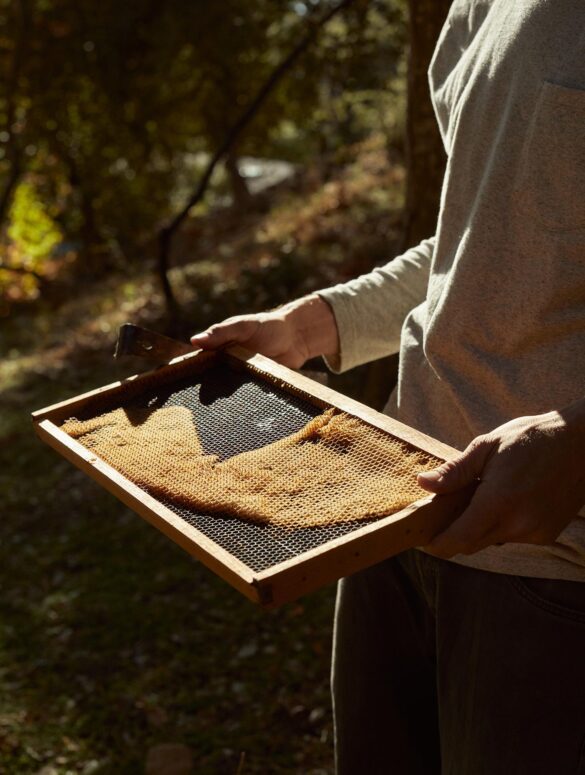Text by Alex Schechter
Images by Cody James
It’s an unusually warm, sunny day in early January, and beekeeper Eli Lichter-Marck is squatting under a canopy of oaks in his Topanga Canyon backyard. He carefully removes the lid from one of his hives. Inside, bees are crawling over the narrow wooden frames, tending their honeycomb. They seem fat and happy, but he is cautious.
“This is just a very sensitive time of year,” explains Lichter-Marck, who maintains more than 400 hives dotted around Topanga and Malibu. “Kind of make-or-break for the bees.”
It’s a pivotal moment, as the bees emerge from the dormant autumn months and the queen begins laying enormous quantities of eggs to grow the hive. And there’s another thing to keep in mind: Los Angeles hasn’t received much rain. This can mean a scarcity of plant nectar in the months ahead, which doesn’t bode well for honey production. “It forces you to approach nature in an analytical way,” Lichter-Marck says.
Keeping bees in Southern California is different than, say, Minnesota, where a four-season cycle yields predictably long, wet summers. In L.A., moisture is not guaranteed, and an extended spring, typically spanning January to May, accounts for almost all of the year’s rainfall.
Depending on how much water comes, the bees will have either a prolific summer or a meager one. On average, Lichter-Mark harvests between 1,800 and 3,000 pounds of honey annually for his company, Eli’s Bees; in a good year, a single hive can yield up to 60 pounds of the golden stuff.
Just as the quantity of honey varies year to year, so, too, do its nuances. To illustrate this point, he sets out three jars of Eli’s Bees’ signature West Malibu honey, all sourced from the hills where the Woolsey Fire burned in 2018.
While two are the color of pale lager and have a bright, candied flavor, the one in the middle is several shades darker and tastes like pine sap with a hint of cinnamon.
The honey is different because the flowers were different, Lichter-Marck explains. As L.A.’s rainy season changes year to year, the environment reacts accordingly.
“A drought honey has a whole different set of flowers, textures, and colors,” he explains, handing me a wooden spoon so I can taste the difference myself. “Rainy-season honey will be lighter and subtly sweet. You can see the transition in the landscape through the honey.”
“As a beekeeper, you’re like a train conductor. The train drives itself—you just keep it on the tracks.”
Eli Lichter-Marck
With challenges like drought and wildfire, the landscape here is particularly resilient; honeybees, brought over by Europeans in the mid-1800s, are vulnerable to such harsh conditions. But over time, as naturalized inhabitants of the Santa Monica mountains, they have proved their worth.
“Honeybees add an additional ecological service,” Lichter-Marck explains. “They enhance pollination.” Not to mention their enticingly bold, complex honey, the kind that Eli’s Bees is known for.
Lichter-Marck’s honey production has increased steadily since 2015, when Greg Blanc, head baker at Gjusta in Venice, invited him to keep bees on Blanc’s property. The resulting honey was sold alongside loaves of sourdough and ciabatta and became an instant hit.
Soon, Lichter-Marck was supplying bulk honey to restaurants like Farmshop in Brentwood, which used his product to make honey biscuits that accompanied the restaurant’s weekly family-style chicken dinners.
In 2018, Lichter-Marck also started offering private honey tastings, which proved equally popular. (He has put a pause on tastings due to the pandemic, but has begun hosting virtual honey tastings over Zoom; he admits the operation is “really ambitious.”)

After sending bees to the Central Valley for almond pollination, it is crunch time for Lichter-Marck. April is when honey production is in full swing, and he typically makes biweekly visits to each of the 20 locations where his hives are located. The chore list is long.
“It’s really hard to just keep the bees alive,” he admits, especially considering a parasite known as the Varroa mite, which has decimated bee populations in North America since the late 1980s.
Despite the odds stacked against him, Lichter-Marck remains charmingly optimistic. He boils down his success as a beekeeper to two factors: rain and stewardship of the hive. The idea is to disrupt the hive as little as possible.
“As a beekeeper, you’re like a train conductor,” he says. “The train drives itself—you just keep it on the tracks.”
Before beekeeping, Lichter-Marck was a medical student at Columbia University, and he approaches his work with the clear-eyed discipline of a scientist: Namely, he’s motivated by a desire to learn what it takes to keep the beehive healthy.
“Honeybees [represent] a part of nature we don’t really understand,” he says. “They’re one of the only domesticated animals who retain their wildness and their mystery. You do what you can to keep the bees happy and healthy. But the bees are living in their own universe.”






